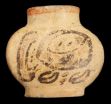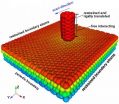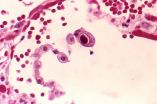(Press-News.org) Troy, N.Y. – A scientist at Rensselaer Polytechnic Institute and an anthropologist from the University at Albany teamed up to use ultra-modern chemical analysis technology at Rensselaer to analyze ancient Mayan pottery for proof of tobacco use in the ancient culture. Dmitri Zagorevski, director of the Proteomics Core in the Center for Biotechnology and Interdisciplinary Studies (CBIS) at Rensselaer, and Jennifer Loughmiller-Newman, a doctoral candidate at the University at Albany, have discovered the first physical evidence of tobacco in a Mayan container. Their discovery represents new evidence on the ancient use of tobacco in the Mayan culture and a new method to understand the ancient roots of tobacco use in the Americas.
Their research will appear in the journal Rapid Communications in Mass Spectrometry, in an article titled "The detection of nicotine in a Late Mayan period flask by GCMS and LCMS methods."
In recent years, archaeologists have begun to use chemical analysis of residues from ancient pottery, tools, and even mummies in an attempt to piece together minute clues about ancient civilizations. Among the potential problems with isolating a residue for analysis is preservation and contamination. Many vessels serve multiple purposes during their lives, resulting in muddled chemical data. Once the vessels are discarded, natural processes such as bacteria and water can destroy the surface of materials, erasing important evidence. Additionally, researchers must be attentive to archaeological field handling and laboratory treatment of the artifacts that might lead to cross contamination by modern sources.
To make their discovery, the researchers had a unique research opportunity: a more than 1,300-year-old vessel decorated with hieroglyphics that seemingly indicated the intended contents. Additionally, the interior of the vessel had not been cleaned, leaving the interior unmodified and the residue protected from contamination.
The approximately two-and-a-half-inch wide and high clay vessel bears Mayan hieroglyphics, reading "the home of his/her tobacco." The vessel, part of the large Kislak Collection housed at the Library of Congress, was made around 700 A.D. in the region of the Mirador Basin, in Southern Campeche, Mexico, during the Classic Mayan period. Tobacco use has long been associated with the Mayans, thanks to previously deciphered hieroglyphics and illustrations showing smoking gods and people, but physical evidence of the activity is exceptionally limited, according to the researchers.
Zagorevski used the technology within CBIS at Rensselaer, usually reserved to study modern diseases and proteins, to analyze the contents of the vessel for the chemical fingerprint of tobacco. The technology included gas chromatography mass spectrometry (GCMS) and high-performance liquid chromatography mass spectrometry (LCMS). Both are analytical chemistry techniques that combine the physical separation capabilities of gas or liquid chromatography with the analysis capabilities of mass spectrometry. The latter is used to determine molecular weights of compounds, their elemental composition, and structural characteristics.
Zagorevski and Loughmiller-Newman's analysis of the vessel found nicotine, an important component of tobacco in residues scrapped from the container. Both techniques confirmed the presence of nicotine. In addition, three oxidation products of nicotine were also discovered. Nicotine oxidation occurs naturally as the nicotine in tobacco is exposed to air and bacteria. None of the nicotine byproducts associated with the smoking of tobacco were found in the vessel, indicating that the vessel housed unsmoked tobacco leaves (possibly powered tobacco) and was not used as an ash tray. No other evidence of nicotine has been found, at this time, in any of the other vessels in the collection.
This discovery "provides rare and unequivocal evidence for agreement between a vessel's actual content and a specific ichnographic or hieroglyphic representation of that content (on the same vessel)," Loughmiller-Newman states in the paper. She is in the anthropology department at the University at Albany, studying ritual food stuff consumed by the Mayans.
Both Loughmiller-Newman and Zagorevski would like to see this technique used to analyze a greater variety of vessel types.
INFORMATION:
Scientists discover the first physical evidence of tobacco in a Mayan container
High technology uncovers an ancient habit
2012-01-13
ELSE PRESS RELEASES FROM THIS DATE:
Why coffee drinking reduces the risk of Type 2 diabetes
2012-01-13
Why do heavy coffee drinkers have a lower risk of developing Type 2 diabetes, a disease on the increase around the world that can lead to serious health problems? Scientists are offering a new solution to that long-standing mystery in a report in ACS' Journal of Agricultural & Food Chemistry.
Ling Zheng, Kun Huang and colleagues explain that previous studies show that coffee drinkers are at a lower risk for developing Type 2 diabetes, which accounts for 90-95 percent of diabetes cases in the world. Those studies show that people who drink four or more cups of coffee daily ...
Why do dew drops do what they do on leaves?
2012-01-13
Nobel laureate poet Rabindranath Tagore once wrote, "Let your life lightly dance on the edges of time like dew on the tip of a leaf." Now, a new study is finally offering an explanation for why small dew drops do as Tagore advised and form on the tips, rather than the flat surfaces, of leaves. It appears in ACS' journal Langmuir.
In the study, Martin E. R. Shanahan observes that drops of water have a preference for exactly where they collect on leaves as their surfaces cool in the morning and afternoon. Those droplets, which condense from water vapor — moisture — in the ...
Advance toward an imaging agent for diagnosing Alzheimer's disease
2012-01-13
Scientists are reporting development and initial laboratory tests of an imaging agent that shows promise for detecting the tell-tale signs of Alzheimer's disease (AD) in the brain — signs that now can't confirm a diagnosis until after patients have died. Their report appears in the journal ACS Medicinal Chemistry Letters.
Masahiro Ono and colleagues explain that no proven laboratory test or medical scan now exists for AD, which is claiming an increasingly heavy toll with the graying of the world's population. Patients now get a diagnosis of AD based on their medical history ...
Best way to boost adult immunizations is through office-based action, study finds
2012-01-13
Promoting immunizations as a part of routine office-based medical practice is needed to improve adult vaccination rates, a highly effective way to curb the spread of diseases across communities, prevent needless illness and deaths, and lower health care costs, according to a new RAND Corporation study.
Increasingly, vaccinations are being offered outside of physician offices at pharmacies, workplaces and retail medical clinics. Even so, office-based medical practice continues to be central to the delivery of recommended vaccinations to adults.
"Regardless of where vaccines ...
Slippery when stacked: NIST theorists quantify the friction of graphene
2012-01-13
Similar to the way pavement, softened by a hot sun, will slow down a car, graphene—a one-atom-thick sheet of carbon with wondrous properties—slows down an object sliding across its surface. But stack the sheets and graphene gets more slippery, say theorists at the National Institute of Standards and Technology (NIST), who developed new software to quantify the material's friction.
"I don't think anyone expects graphene to behave like a surface of a three-dimensional material, but our simulation for the first time explains the differences at an atomic scale," says NIST ...
NIST standard available for better diagnosis, treatment of cytomegalovirus
2012-01-13
A new clinical Standard Reference Material (SRM) from the National Institute of Standards and Technology (NIST) will help health care professionals more accurately diagnose and treat cytomegalovirus (CMV), a common pathogen that is particularly dangerous for infants and persons with weakened immune systems.
CMV is found in 50 to 80 percent of the population. It is a member of the herpes family of viruses that includes two herpes simplex viruses (the causes of cold sores and genital herpes), the varicella-zoster virus (the cause of chicken pox and shingles) and the Epstein-Barr ...
Stretching exercises: Using digital images to understand bridge failures
2012-01-13
With a random-looking spatter of paint specks, a pair of cameras and a whole lot of computer processing, engineer Mark Iadicola of the National Institute of Standards and Technology (NIST) has been helping the Federal Highway Administration (FHWA), in cooperation with the American Association of State Highway and Transportation Officials (AASHTO), to assure the safety of hundreds of truss bridges across the United States. Iadicola has been testing the use of a thoroughly modern version of an old technique—photographic measurement or "photogrammetry"—to watch the failure ...
NIST releases 2 new SRMs for monitoring human exposure to environmental toxins
2012-01-13
The National Institute of Standards and Technology (NIST), in collaboration with the Centers for Disease Control and Prevention (CDC), has developed two new Standard Reference Materials (SRMs) for measurements of human exposure to environmental toxins. Used as a sort of chemical ruler to check the accuracy of tests and analytic procedures, the new reference materials replace and improve older versions, adding measures for emerging environmental contaminants such as perchlorate, a chemical that the Environmental Protection Agency has targeted for regulation as a contaminant ...
Outlook for an industry that touches 96 percent of all manufactured goods
2012-01-13
The chemical industry, which touches 96 percent of all manufactured goods, is seeing some positive signs for 2012, although the overall outlook is not very rosy. Growing demand for chemicals used in agriculture, electronics, cars and airplanes will boost an industry that generates $674 billion in sales in the U.S. alone, but expiring patents and global economic woes will take a toll. These forecasts and others are in the cover story in the current issue of Chemical & Engineering News (C&EN), the weekly newsmagazine of the American Chemical Society, the world's largest scientific ...
'I feel your pain ...'
2012-01-13
Imagine the following scenarios: a co-worker is spoken to condescendingly, excluded from a meeting, or ignored by a supervisor. How does it make you feel? Do you feel differently depending on whether your co-worker is a man or a woman? According to a new study, workers who witness incivility towards colleagues feel negative emotions – especially when the incivility is aimed at workers of the same sex. The work, by Kathi Miner from Texas A&M University and Angela Eischeid from Buena Vista University, Iowa, is the first to look at the relationship between employees' observations ...
LAST 30 PRESS RELEASES:
This new understanding of T cell receptors may improve cancer immunotherapies
A new fossil face sheds light on early migrations of ancient human ancestor
A new immunotherapy approach could work for many types of cancer
A new way to diagnose deadly lung infections and save lives
40 percent of MRI signals do not correspond to actual brain activity
How brain-inspired algorithms could drive down AI energy costs
Gum disease may be linked to plaque buildup in arteries, higher risk of major CVD events
Contrails are a major driver of aviation’s climate impact
Structure of dopamine-releasing neurons relates to the type of circuits they form for smell-processing
Reducing social isolation protects the brain in later life
Keeping the heart healthy increases longevity even after cancer
Young adults commonly mix cannabis with nicotine and tobacco
Comprehensive review illuminates tau protein's dual nature in brain health, disease, and emerging psychiatric connections
Book prepares K-12 leaders for the next public health crisis
Storms in the Southern Ocean mitigates global warming
Seals on the move: Research reveals key data for offshore development and international ecology
Sports injuries sustained during your period might be more severe
World's first successful 2 Tbit/s free-space optical communication using small optical terminals mountable on satellites and HAPS
Can intimate relationships affect your heart? New study says ‘yes’
Scalable and healable gradient textiles for multi‑scenario radiative cooling via bicomponent blow spinning
Research shows informed traders never let a good climate crisis go to waste
Intelligent XGBoost framework enhances asphalt pavement skid resistance assessment
Dual-function biomaterials for postoperative osteosarcoma: Tumor suppression and bone regeneration
New framework reveals where transport emissions concentrate in Singapore
NTP-enhanced lattice oxygen activation in Ce-Co catalysts for low-temperature soot combustion
Synergistic interface engineering in Cu-Zn-Ce catalysts for efficient CO2 hydrogenation to methanol
COVID-19 leaves a lasting mark on the human brain
Scientists use ultrasound to soften and treat cancer tumors without damaging healthy tissue
Community swimming program for Black youth boosts skills, sense of belonging, study finds
Specific depressive symptoms in midlife linked to increased dementia risk
[Press-News.org] Scientists discover the first physical evidence of tobacco in a Mayan containerHigh technology uncovers an ancient habit


